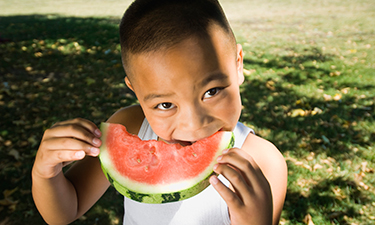 Park and recreation agencies may be eligible to receive funding to provide healthy meals to children 18 years and younger in low-income areas through the Afterschool and Summer Meal Programs. These programs ensure that children receive nutritious meals year-round when they are susceptible to hunger or may replace those meals with unhealthy snacks. As local government entities, park and recreation agencies are able to sponsor both programs. They are ideal sites for summer and afterschool meals because they provide activities for children in safe locations that are familiar to families, and they are often open year-round.
Park and recreation agencies may be eligible to receive funding to provide healthy meals to children 18 years and younger in low-income areas through the Afterschool and Summer Meal Programs. These programs ensure that children receive nutritious meals year-round when they are susceptible to hunger or may replace those meals with unhealthy snacks. As local government entities, park and recreation agencies are able to sponsor both programs. They are ideal sites for summer and afterschool meals because they provide activities for children in safe locations that are familiar to families, and they are often open year-round.
The Afterschool Meal Program is available through the Child and Adult Care Food Program (CACFP) and can operate when the school day ends, on weekends and during school holidays.
“USDA’s Child and Adult Care Food Program is an important component of our nation’s safety net against hunger that...touch[es] the lives of one in five Americans each year,” says Kevin Concannon, USDA undersecretary for food, nutrition and consumer services.
Summer meals are offered through the Summer Food Service Program (SFSP), and the program takes place when the school year ends. About 21 million children nationwide receive free and reduced-priced meals through the National School Lunch Program during the school year, and only about 3 million kids are fed through USDA programs in the summer. “National Recreation and Park Association members can help connect eligible kids with summer meals by sponsoring sites in their area,” says Concannon. SFSP can increase attendance at your program, ensure healthy meals are served, provide children with the energy needed to engage in activities and help families who struggle to afford healthy meals.
Qualifying to participate in the Afterschool and Summer Meal Programs is based on location, or what’s known as “area eligibility.” No individual applications from participating children are necessary. To be eligible, afterschool or summer programs must be located in or near an elementary, middle or high school where 50 percent or more of the students qualify for free or reduced-price meals. Summer sites may also use Census data to qualify their sites. Once qualified, the programs are open to all participating students.
Increasing participation has its benefits. Sponsors are reimbursed for each meal or snack they serve, and the funding increases as the program grows. For example, an afterschool program that serves both a meal and a snack to 50 children could receive $35,662 based on a 180-day school year. Serving a snack alone provides a program $7,200 in funding. A snack is an excellent start, but a program receives greater funding and children receive more nutrition if both a meal and a snack are served. During the summer, children get more nutrition and programs receive more funding when both breakfast and lunch are served. A summer program serving both meals to 50 children would receive $10,710 in funding, based on a 40-day summer.
Meals must meet nutrition standards set by USDA and can be served hot or cold. Successful programs find that offering fresh, high-quality food that is appealing to children can lead to more participation and teach children the importance of nutritious meals.
This past summer, USDA’s Food and Nutrition Services worked closely with programs in specific states, including some park and recreation agencies, to increase access to and participation in Summer and Afterschool Meals. For example, the state of Rhode Island worked directly with the Providence Parks and Recreation Department to increase participation by enhancing outreach efforts, including the installation of six-foot banners at city hall promoting SFSP in both English and Spanish. Staff also coordinated a number of events with summer lunch to draw children to the parks, including “Touch-a-Truck,” in conjunction with the Providence Fire Department and zoo mobile visits in conjunction with Roger Williams Park.
Now is the time to make plans for 2014! To contact your state agency to determine your eligibility, visit www.fns.usda.gov/cnd/Contacts/StateDirectory.htm. They provide the application, training and assistance to fund the Afterschool and Summer Meal Programs. Learn more at http://www.frac.org/programs.
Signe Anderson is a Child Nutrition Policy Analyst for the Food Research and Action Center. Kellie May is NRPA’s Senior Program Manager.

